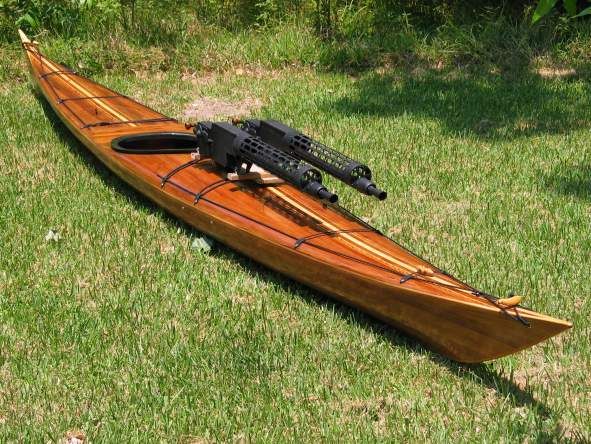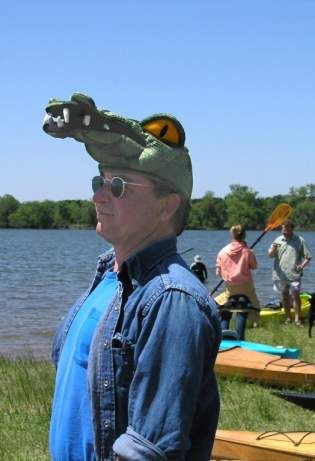|
The Building of Another One, With Lots More Construction Detail, Hints & Tips
|
My One and Only Homemade Canoe So Far, Lots of Construction Detail, Hints & Tips
|
Welcome to
THE SAWDUST FACTORY
My personal "how-I-did-it" web site featuring homemade kayaks, canoes, paddles, and telescopes, microscopes, and maybe a few other assorted odds and ends.
TABLE OF CONTENTS
|
The Building of Another One, With Lots More Construction Detail, Hints & Tips
|
My One and Only Homemade Canoe So Far, Lots of Construction Detail, Hints & Tips
|
|
Two Major Remodel Jobs To My First Sea Kayak To Facilitate Advancing Skills
|
My Take on Traditional Inuit-style Paddles for Sea Kayaking
|
|
Making "Bird's Mouth" Hollow Shaft Canoe Paddles A Tip Of The Hat to Duckworks, and Messabouters Everywhere!
|
Making A Simple Beavertail Canoe Paddle You Want Easy? Here's Easy
|
|
This Still Knocks Me Out Every Time!
|
|
Vintage Microscopes For Indoor Fun |
My 16" f/5 Dobsonian
|
|
Reporting On My First, 20 years Later
|
Cool Way To Make a Dob Track the Sky
|
|
Tailoring a Table Saw for a Perfect Fit!
|
The Sawdust Factory: Your Home For Serious Kayaking Fun!

The Sawdust Factory is my personal web site where I strive to provide quality interwebz content that is educational and/or entertaining, and to freely pass along knowledge which was given freely by others, and/or laboriously gained through appalling screw ups of my own, where applicable, as pertains to the hobbies and/or avocations of the following party, me, Kurt Maurer.
There is nothing for sale here; it is all merely a compiled post, or composted pile, of free friendly advice that you are welcome to take or leave as you see fit. We here at The Sawdust Factory welcome email with your comments, tips, suggestions, feedback, manifestos, etc.
Please write to Kurt Maurer at NGC704@AOL.COM
Legal Notice/Disclaimer: Please do not blame me if you drown or cut your fingers off, please use as directed, some side effects may be experienced, or some swelling may occur; some subject matter may be unsuitable for some audiences, void where prohibited, batteries not included, no conditions apply, call your physician if erection lasts more than four hours.
Store-Bought Boats: Some folks may think I'm a "purist", but I deny the charges. I'm just a guy who can't afford to plunk down thousands on toys, so I get out the hammer and saw and get busy instead. Knowing how to build boats means knowing how to fix them too, so sometimes I get killer deals on damaged goods I can repair to perfectly serviceable condition. The following are perfect examples, purchased for well under half of what they would normally cost. And while they are factory made, I'm still proud to own and love to paddle them.
|
|
|
Left: Wenonah J-201, a USCA C-1 Solo Racing Canoe; Right: Wenonah Advantage, a high-performance solo canoe. Both in ultralight Kevlar layup. |
|
|
|
Above: Composite Valley Nordkapp LV, at play in Galveston Bay! |
The Prospective Boat Builder Asks: "What do I need to know to get started?" I often get email asking this question, and my reply usually goes something like this:
Here are a few
general tips for a newcomer to boat building:
The most common methods for building small craft like kayaks and canoes are
"stitch-and-glue", or S&G for short, "strip-building",
or strippers for short, and skin-on-frame, or SOF for short (since I'm not a SOF
builder I'll leave that discussion to others). You'll occasionally hear of hybrids, which
usually means a thin S&G thin plywood hull with a stripped deck. As a rule
of thumb, S&G boats take roughly 80 hours to build, strippers 300, hybrids predictably in between at around 150
hours. Consistent with the nature of the respective methods, S&G typically results in hard-chine hulls, strip building
more rounded ones. This is why canoes are most often seen as strippers. Strippers also
look most spectacular.
Which method is easier? Depends on your attitude and what you want to
accomplish; nobody can answer this one for you. At any rate, lots of noobies
tackle strippers as first projects and fare just fine, although there's no doubt
S&G can hedge the bets and boost confidence for others.
What does it cost? Depends on a few variables. Are you a devoted scrounger, or do you grab your wallet and dash off to the store to buy what you
need or want as a reflexive action? Do you already have basic tools, or are you truly starting from the ground up? Plans, or kit?
The low end can be, say, $250 to $300, and the sky's the limit on the upper end. Most folks get into their first
canoe or kayak for $400 to $1000+; the low end representing the noobie who already has
shop and tools, and the high end the person who orders a kit, and otherwise
makes purchases freely.
Plans or Kit? Depends on
what you want or need. Kits can be huge time-savers, but you pay extra for
convenience. For those wanting to keep it as inexpensive as possible, building
from plans doesn't add significant complexity, all things considered, but is way
more economical . . . and no question about it, more personally rewarding.
Buying a kit doesn't make it "easy", however, and those who go that
route still get credit for having built their own boat.
Kayak or canoe? Again, nobody can answer that one for you. Kayaks tend to be more popular because they generally
demand less skill to make 'em behave, and are less prone to wind. Canoes tend to be overlooked in Texas, but much more popular up north where folks appreciate the
relatively unlimited capacity to tote ice chests, dogs, fishing tackle, kids,
wives, etc., etc., etc. I think you need both, and since you're building your
own, you can afford it!
When you build your own, you can, and should, customize your boat in minor ways to best suit your own needs -- no sense in going with a one-size-fits-all plan; the designer gives you a good solid basis, but not a gospel.
And it's perfectly okay to get more daring; for example, if you like the idea of a canoe, and live on the
breezy coast, take a hint from the race community and lower the gunnels a few
inches for a lesser wind profile and carry a sponge (which is a great idea in any small boat).
Most builders end up building two or three boats,
if not more. Each successive one tends to get cheaper, lighter, and easier.
In my opinion, the best way to get started is to buy books and stick 'em in the bathroom, and in
no time you'll have quite a lot of knowledge regarding this nutty business. Here
are two excellent titles to start with for a well-rounded look at contemporary
wood canoe/kayak building:
"Building Strip-Planked Boats" by Nick Schade ("The Strip-Built Sea Kayak" is Nick's previous opus, and still very nearly just as good.)
"The New Kayak Shop" by Chris Kulczycki (formerly of Chesapeake Light Craft,
the best in business for S&G boat plans and kits.)
After those, Ted Moores has several published titles to his credit which tend to be top-of-the-heap. After that, anything you can get your hands on
is never time or money wasted in my opinion.
And for the newcomer to paddling: Please stay away from super heavy boats. The $250 canoes
that BigBox tantalizes you with seldom get used more than two or three times, because the
owners start going to chiropractors and hernia specialists instead. Avoid tandems, we call 'em "divorce boats" for good reason. Any cheap solo boat
that you can reasonably handle on and off the water will teach you far more than any jaw-flapper or book author ever can.
The brightly colored plastic ten- and twelve foot plastic kayaks at BigBox should
NOT be ruled out. They tend to be very easy to handle on and off the water,
store easily, car-top well, and fit in the back of most pickups and SUV's so you
don't even have to mess with racks and straps right off. And if you outgrow it, they're very easy to
resell.
A Few Select Boat Building Links:
John Caldeira's Web Site: A wealth of wisdom you won't find anywhere else.
Laughing Loon Kayaks: Rob Macks' shop tips have proven invaluable over the years.
One Ocean Kayaks: Vaclav Stejskal is another saintly soul who offers absolutely indispensable shop tips.
Blue Heron Kayaks: Ross Leidy offers a trove of great ideas, also home of his Kayak Foundry design software.
Guillemot Kayaks: Nick Schade is the dean of strip-built sea kayak building, the guy who literally wrote The Book for strip-building, and provides the Kayak Builder's Board.
Chesapeake Light Craft: John Harris & Co. also provide a brilliant Builder's Forum, as well as The Book for Stitch-n-Glue, and really bend over backwards to make boat builders out of dreamers. I got my start with these two books, forums, and a set of CLC Mill Creek 13 plans.
Raka Inc.: Raka 350/127 is my epoxy and hardener of choice, and Larry Steeves has always provided most excellent service.
Sweet Composites: This is where I get most of my other stuff, like glass, carbon fiber, and kevlar cloths, shock cord, foot braces, etc.
Duckworks: What can I say? With a name like that it has to be good!
Note: The commercial outfits listed above offer excellent products and services, and I recommend them. I hope you will spend lots of money buying their stuff, or donating generously as the case may be. Remember, every dollar they get only encourages more excellent designs, products, and services from them . . . and believe me, nobody gets rich in this business. Also note that all opinions expressed herein are mine, and mine alone; I receive no recompense or other forms of bribery, etc., batteries not included, etc., etc. Thank you, etc., etc., etc.
Email Kurt Maurer at NGC704@aol.com

Last Updated: 11-23-15
Copyright Kurt Maurer League City Texas May 1, 2011